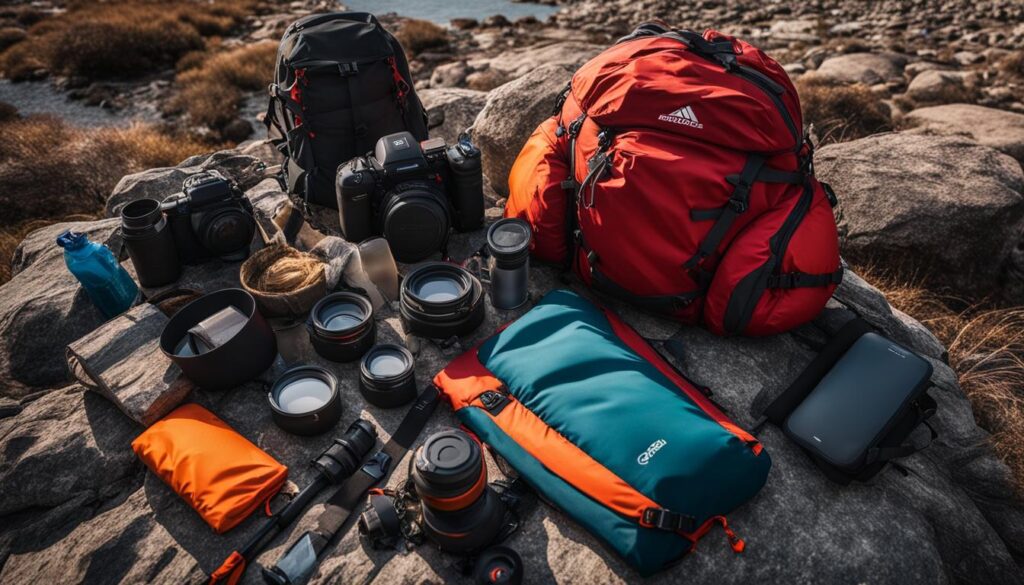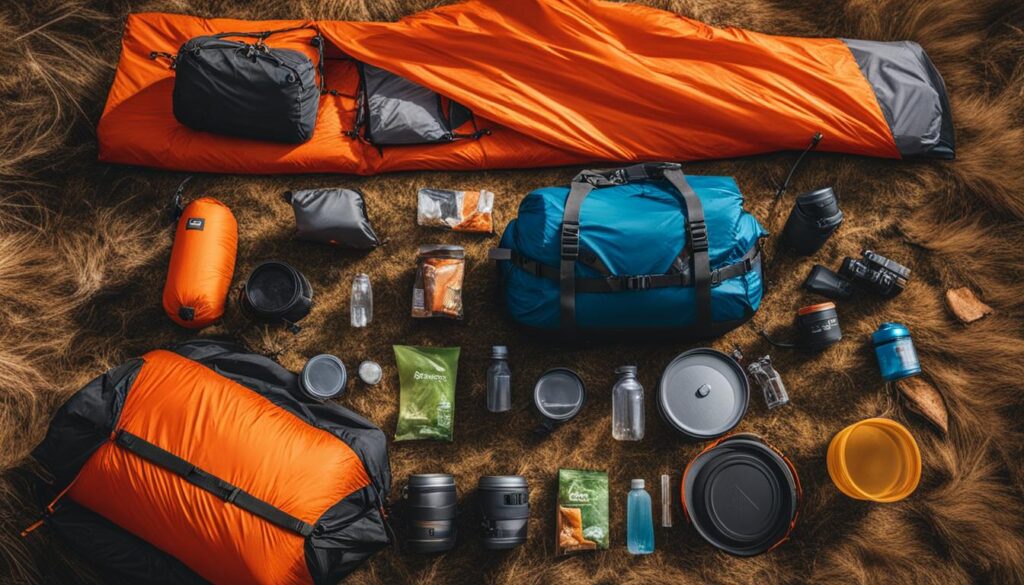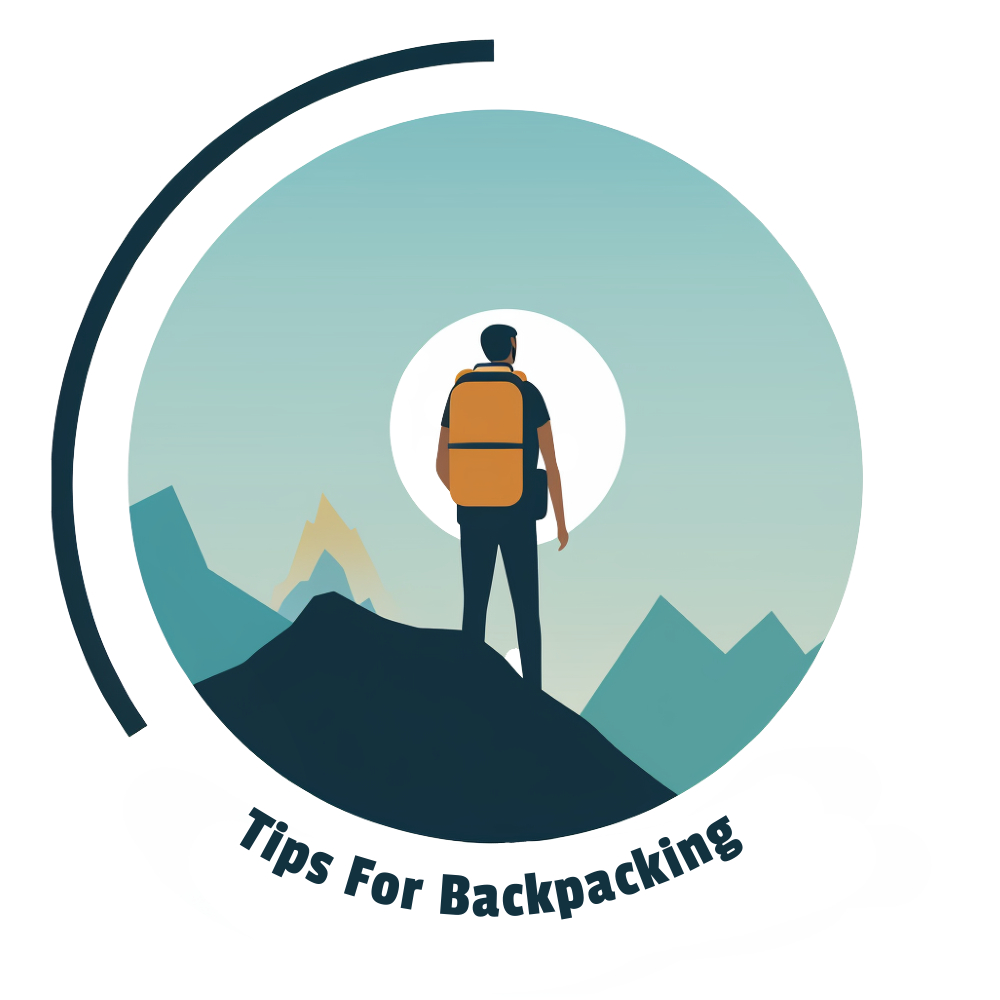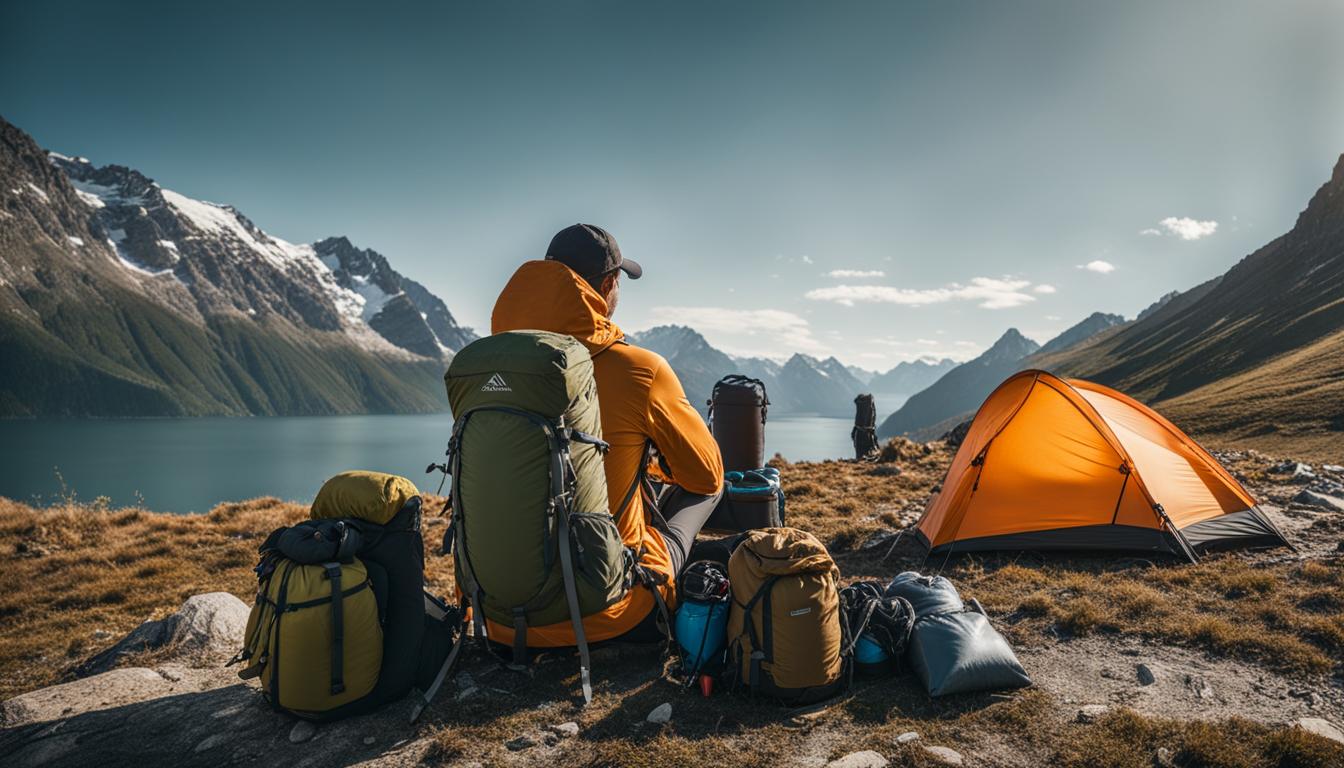Ultralight backpacking has become a popular trend among outdoor enthusiasts who want to shed the weight of their packs while still enjoying the beauty of nature. In this section, I will explore the essential steps of planning an ultralight backpacking trip, including evaluating your needs and goals, trip planning and route selection, and safety considerations.
Key Takeaways:
- Planning an ultralight backpacking trip involves evaluating needs, setting goals, and considering safety.
- Ultralight backpacking tips and tricks can help reduce weight and improve efficiency.
- Choosing the right gear is crucial for a successful lightweight backpacking experience.
- Essential gear recommendations include shelters, backpacks, sleeping quilts, sleeping pads, and footwear.
- By following this guide, you can embark on an unforgettable lightweight backpacking journey.
Ultralight Backpacking Tips and Tricks

When it comes to ultralight backpacking, every ounce counts. Here are some valuable tips and tricks to help you reduce weight, make efficient gear selections, and master the art of packing for your adventure.
Weight Reduction Strategies
- Analyze Your Gear: Evaluate each piece of equipment and consider if there are lighter alternatives available. Look for gear made from lightweight materials such as carbon fiber or titanium.
- Multi-Purpose Items: Opt for gear that serves multiple functions, like a tent that doubles as a trekking pole or a cooking pot that can also be used as a bowl.
- Minimize Toiletries and Luxury Items: Only pack the essentials and leave behind unnecessary items like full-sized toiletries or extra camp comforts.
Gear Selection Considerations
Choosing the right gear is crucial for ultralight backpacking. Consider the following factors when making your selections:
- Weight-to-Function Ratio: Prioritize gear that provides a good balance between weight and functionality. Don’t sacrifice essential features for the sake of reducing weight.
- Durability and Reliability: Ensure your gear is built to withstand the rigors of the trail. Opt for high-quality materials and reputable brands.
- Comfort and Fit: Test out gear to ensure it fits properly and is comfortable for long hikes. Ill-fitting gear can lead to discomfort and even injury.
- Read Reviews: Research and read reviews from experienced backpackers to gain insights into the performance and durability of different gear options.
Efficient Packing Techniques and Trail Skills
Efficient packing can make a significant difference in reducing weight and maximizing space in your backpack. Here are some techniques to help you pack smart:
- Organize by Weight and Accessibility: Pack heavier items closer to your back and lighter items towards the top. Keep frequently used items easily accessible.
- Utilize Compression and Organization Tools: Use compression sacks or packing cubes to maximize space in your pack and keep items tidy.
- Practice Leave No Trace Principles: Minimize your impact on the environment by following Leave No Trace principles, such as packing out all trash and minimizing campfire impact.
By implementing these ultralight backpacking tips and tricks, you can significantly reduce the weight of your pack without sacrificing comfort or safety. Remember, every gram counts when you’re hitting the trails, so analyze your gear, make informed selections, and pack efficiently. Happy backpacking!
Essential Ultralight Gear Recommendations

When it comes to ultralight backpacking, choosing the right gear is crucial. Every ounce counts, so selecting lightweight and functional equipment is essential for a successful trip. In this section, I will provide you with my top recommendations for essential ultralight gear, including shelters, backpacks, sleeping quilts, sleeping pads, and footwear.
Shelters
When selecting a shelter for ultralight backpacking, there are several options to consider. Tents are a popular choice, providing protection from the elements and bugs. Look for lightweight models made from durable materials like Dyneema or silnylon. Alternatively, tarps offer a minimalist and lightweight option, providing shelter from rain while maximizing ventilation. Hammocks are another lightweight choice, perfect for areas with trees, and they provide a comfortable sleeping option. Lastly, bivy sacks are ideal for solo backpackers who prioritize weight reduction and simplicity.
Backpacks
Choosing the right backpack is crucial for an ultralight backpacking trip. Look for packs made from lightweight and durable materials like Dyneema or Cuben Fiber. Additionally, consider the volume and capacity of the pack to ensure it can comfortably hold all your gear while still remaining lightweight. Look for packs with comfortable padding and adjustable straps to provide support and distribute the weight evenly.
Sleeping Quilts and Sleeping Pads
When it comes to sleeping gear, quilts are a popular and lightweight alternative to sleeping bags. They provide warmth while minimizing weight and bulk. Look for quilts made with high-quality insulation and materials like down or synthetic insulation. Additionally, consider the temperature rating of the quilt to ensure it suits the conditions of your trip. Sleeping pads are essential to provide comfort and insulation from the ground. Opt for lightweight and compact options that offer sufficient cushioning and warmth while minimizing weight and volume.
Footwear
Choosing the right footwear is crucial for any backpacking trip, especially when going ultralight. Look for lightweight hiking shoes or trail runners that provide the necessary support and traction for the terrain you’ll be traversing. Consider the durability and breathability of the shoes to ensure they can withstand the demands of the trail. Additionally, choose shoes that fit well and provide ample toe space, as foot comfort is essential for long-distance hikes.
| Item | Weight | Features |
|---|---|---|
| Tent | 2 lbs | Freestanding, waterproof, and easy to set up |
| Tarp | 12 oz | Lightweight, versatile, and offers excellent ventilation |
| Hammock | 1.5 lbs | Comfortable, easy to set up, and perfect for tree-dense areas |
| Bivy Sack | 1 lb | Minimalist, lightweight, and offers protection from the elements |
| Backpack | 2.5 lbs | Lightweight, durable, and designed for optimal weight distribution |
| Sleeping Quilt | 1 lb | Warm, lightweight, and compressible; perfect for ultralight backpacking |
| Sleeping Pad | 8 oz | Lightweight, compact, and provides insulation and comfort |
| Hiking Shoes | 1.2 lbs | Lightweight, durable, and provide excellent traction and support |
What Lightweight Gear Should I Bring for Ultralight Backpacking?
When planning for ultralight backpacking, it’s crucial to pack the right ultralight backpacking essentials. Some key items to consider are a lightweight tent, compact sleeping bag, portable stove, water purifier, and durable backpack. These items will help minimize weight without sacrificing functionality on the trail.
Conclusion
So, there you have it – the ultimate guide to lightweight backpacking gear! In this guide, I’ve covered everything you need to know about planning an ultralight backpacking trip, from evaluating your needs and goals to route selection and safety considerations. I’ve also shared some valuable tips and tricks for reducing weight, selecting the right gear, and packing efficiently.
When it comes to essential ultralight gear, I’ve provided recommendations for shelters, backpacks, sleeping quilts, sleeping pads, and footwear. Whether you prefer a tent, tarp, hammock, or bivy sack for shelter, I’ve got you covered. And don’t worry about sacrificing comfort – there are plenty of lightweight options for sleeping quilts and sleeping pads to keep you cozy throughout the night. Let’s not forget about the importance of lightweight and supportive footwear to keep your feet happy on the trail.
By following the advice and recommendations in this guide, you’ll be well-prepared to embark on an unforgettable journey into the wilderness while minimizing the weight of your pack. So, gear up, pack light, and get ready for an incredible ultralight backpacking adventure!

